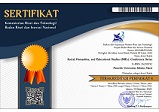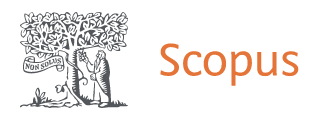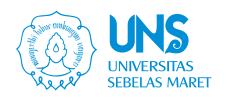Penerapan Pendekatan Realistik Matematika Edukasi (RME) terhadap Kemampuan Representasi Matematis Siswa Sekolah Dasar
Abstract
Elementary school students’ mathematical representation skills are still rather limited as conventional teaching approaches abound and fall short of appropriately connecting theoretical ideas to actual situations. This study seeks to understand how the Realistic Mathematics Education (RME) strategy influences pupils’ capacity for mathematical representation. Employing A control group for the pretest and posttest strategyThe research method quasiexperimental. Included were two consciously selected fourth-grade classes in Tigaraksa District, Tangerang Regency. The experimental group got RME-based schooling while the control group underwent conventional instruction. The instrument of investigation was a descriptive study evaluating representational abilities in symbolic, visual, and verbal formats. Using SPSS, the data wes then analyzed using homogeneity, normality, matched sample t-test, as well as an independent sample t-test. The study showed an average of 13 points distinction between the posttest and results of the control group and those of the experimental group, indicating a major improvement in pupils’ results. This finding helps the theory that the RME technique can improve students’ ability to represent mathematical concepts a lot. Consequently, at the primary school level, the RME approach has proven to be effective in improving mathematical understanding in a more contextual and significant.
Kemampuan representasi matematis siswa sekolah dasar masih tergolong rendah akibat dominasi metode pembelajaran konvensional yang kurang mengaitkan konsep abstrak dengan situasi nyata. Penelitian ini bertujuan untuk mengkaji pengaruh pendekatan Realistik Matematika Edukasi (RME) terhadap peningkatan kemampuan representasi matematis siswa. Dengan menggunakan strategi control group pretest-posttest, metode penelitian ini adalah kuasi eksperimen melibatkan dua kelas IV di Kecamatan Tigaraksa, Kabupaten Tangerang yang dipilih secara purposif. Kelompok eksperimen memperoleh pembelajaran berbasis RME, sedangkan kelompok kontrol mendapat pembelajaran konvensional. Insturmen penelitian berupa tes uraian yang mengukur kemampuan representasi dalam bentuk simbolik, visual, dan verbal, kemudian dianalisis menggunakan uji normalitas, homogenitas, paired sample t-test, dan independent sample t-test dengan bantuan SPSS. Hasil analisis menunjukkan bahwa terdapat peningkatan yang signifikan pada skor posttest siswa di kelas eksperimen dibandingkan dengan kelas kontrol, dengan rata-rata selisih 13 poin. Temuan ini menegaskan bahwa pendekatan RME secara signifikan dapat meningkatkan kemampuan representasi matematis siswa. Dengan demikian, pendekatan RME terbukti efektif mampu meningkatkan pemahaman matematika secara lebih kontekstual dan signifikan.
Keywords
Full Text:
PDFReferences
Freudenthal, H. (2002). Revisiting mathematics education: China lectures. Dordrecht: Springer Netherlands.
Gravemeijer, K. P. E. (1994). Developing realistic mathematics education.
Bito, G. S. (2014). Aktivitas bermain sebagai konteks dalam belajar matematika di sekolah dasar dengan pendekatan matematika realistik. Jurnal Pemikiran dan Pengembangan Sekolah Dasar (JP2SD), 1(4), 250-255.
Kohar, AW, Fachruddin, AD, & Widadah, S. (2021). Memfasilitasi Kecerdasan Majemuk Siswa melalui Pembelajaran Berbasis Realitas Terpadu (RME): Sebuah Lintasan Pembelajaran Pengukuran Volume dan Luas Permukaan. Inomatika , 3 (1), 27-50.
Fauzan, A. (2002). utilizing Realistic Mathematics Education (RME) to teach geometry in elementary schools in Indonesia.
Pape, S. J., Bell, C. V., & Yetkin, I. E. (2003). Developing mathematical thinking and self-regulated learning: A teaching experiment in a seventh-grade mathematics classroom. Educational Studies in Mathematics, 53(3), 179-202.
Suryadi, D. (2005). Penggunaan pendekatan realistik dalam pembelajaran matematika di Indonesia. Makalah disajikan pada Seminar Nasional Pendidikan Matematika, Universitas Pendidikan Indonesia, Bandung.
Van den Heuvel-Panhuizen, M. H. A. M. (2001). Realistic mathematics education in the Netherlands. In Principles and Practice in Arithmetic Teaching: Innovative approaches for the primary classroom (pp. 49-63). Open University Press.
Principles, N. C. T. M. (2000). math standards in schools. Mathematical Teachers' National Council, Reston, VA.
Yulianti, K., & Wahyudin. (2018). The influence of realistic mathematics education approach on students’ mathematical representation ability. Journal of Mathematics Education, 9(2), 123-134.
Goldin, G. A. (2002). Representation in mathematical learning and problem solving. In L. D. English (Ed.), Handbook of international research in mathematics education (pp. 197-218). Lawrence Erlbaum.
Lesh, R., Post, T. R., & Behr, M. (1987). Representations and translations among representations in mathematics learning and problem solving. In Problems of representations in the teaching and learning of mathematics (pp. 33-40). Lawrence Erlbaum.
Sugiyono, D. (2013). Metode penelitian pendidikan pendekatan kuantitatif, kualitatif dan R&D.
Creswell, J. W. (2002). Educational research: Planning, conducting, and evaluating quantitative (Vol. 7). Prentice Hall Upper Saddle River, NJ.
Sugiyono, D. (2017). Prof Statistik untuk Penelitian Bandung: Penerbit Alfabeta Bandung
Priyatno, D. (2013). Mandiri belajar analisis data dengan SPSS. Yogyakarta: Mediakom.
Kementerian Pendidikan dan Kebudayaan RI. (2022). Panduan Pembelajaran dan Asesmen. Jakarta: Pusat Kurikulum dan Pembelajaran, Balitbang & Perbukuan.
Refbacks
- There are currently no refbacks.





